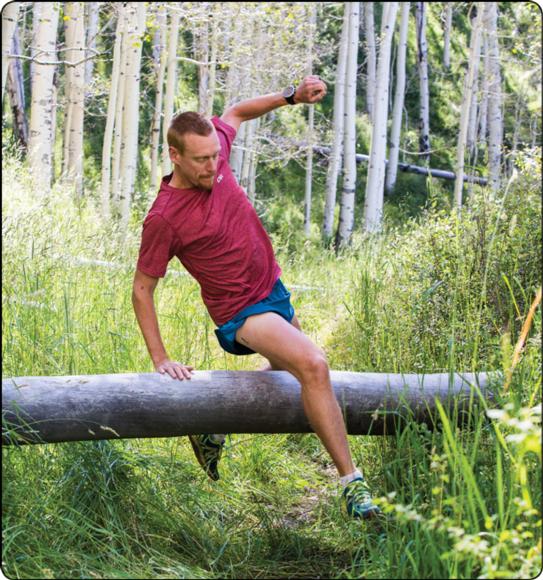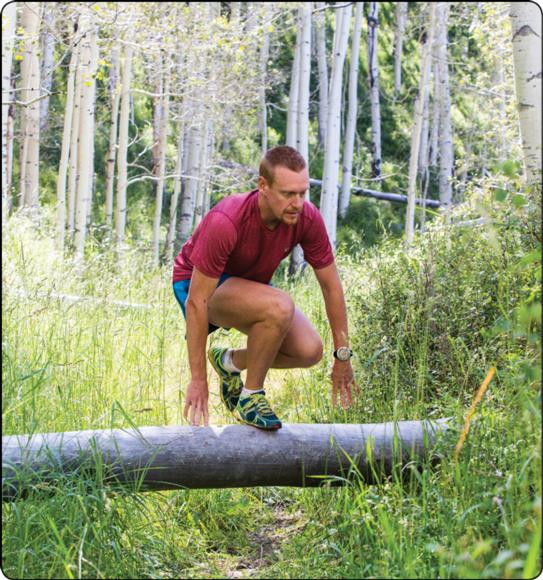Trees, Boulders, and Streams, Oh My!
This is an excerpt from Where the Road Ends by Meghan M Hicks,Bryon Powell.
As you may have recognized by now, the challenges of trail running are often its rewards. Figuring out how to negotiate obstructions on the trail and actually doing so can be a blast. Some folks pay $100 or more to participate in an obstacle-course race that's here today and gone tomorrow. Well, the same thing can happen any day on the trails. Fallen trees, boulders, water crossings - trail running has them and more.
Downed Trees
Toppled trees are a routine impediment for those who run forested trails. Wind, rain, snow, fire, and time can all lay logs across your desired path, leaving you with three choices: over, under, or around.
In most cases, your preferred option for dealing with a downed tree will be to go over it. If the log is small or lies below your knee, all you have to do is step over it. No big deal.
If the top of the log is between your knee and midthigh, you might be able to step carefully over it sideways, kicking one leg over before the other. Alternatively, you can place one foot on the log and step the other leg over. You can take a break with both feet on the log, if you prefer. If the log appears at all slick, take care to place your foot or feet on the log with a vertical motion to reduce your chances of slipping. When stepping off a potentially slippery log, lean forward and drop your leading foot toward the ground before picking your rear foot up. Trying to push off horizontally with your trailing foot can lead to perilous slippage.
If the top of the downed tree falls from midthigh to slightly above waist height, you can try swinging your legs over it in several ways. One option is to plant one hand on the log as you step over it, lean slightly toward that arm, using it for a little extra "hang-time" as you take the log in stride. As an alternative, you might be able to lift one foot on top, put your hands to both sides of that foot, and then pull the trailing foot through straight to the other side. In a final option, turn away from the log but put both hands on it. Lift yourself so that you sit on the log. Now, swing your legs, one at a time or together, from one side of the log to the other before lowering yourself back down the other side.

If a log is low enough, planting one hand can get you over.

Planting both hands can offer stability when crossing a log.

When needed, you can sit on the log and swing your legs over.
If climbing over a tree won't work, try going under it. Going under a tree might be as simple as ducking. If the trunk is high enough, you might have success in crouching while running below the barrier. Chances are, however, that you'll have stopped in your tracks already. If that's the case, bend your knees and waist, hunch over, and walk slowly forward. Putting one hand on the log above you can give you a good sense of its location so that you're less likely to bump your head or, if you're wearing one, catch your hydration pack. Although getting hung up is still annoying, you're far more likely to do the latter than the former. Depending on how far you're bent over, you can put a hand on the ground to balance. In some cases, crawling under the downed tree is the best option. Just remember to watch out for your head and pack.
Presumably, if you can go around a downed tree while staying on the trail, you don't really have much of an obstruction, do you? That being the case, you should go around a downed tree by leaving the established trail only if going over or under it is unreasonably dangerous, impossible, or would literally take minutes to crawl your way through the branches. With that said, if an apparent trail reroute goes around the downed tree, follow it. If a new trail has not been established, take the shortest easily negotiated path around the tree while taking care to minimize damaging vegetation. If you can easily open up a blocked trail by breaking branches off the downed tree, feel free to do so.
SHOP

Get the latest insights with regular newsletters, plus periodic product information and special insider offers.
JOIN NOW


